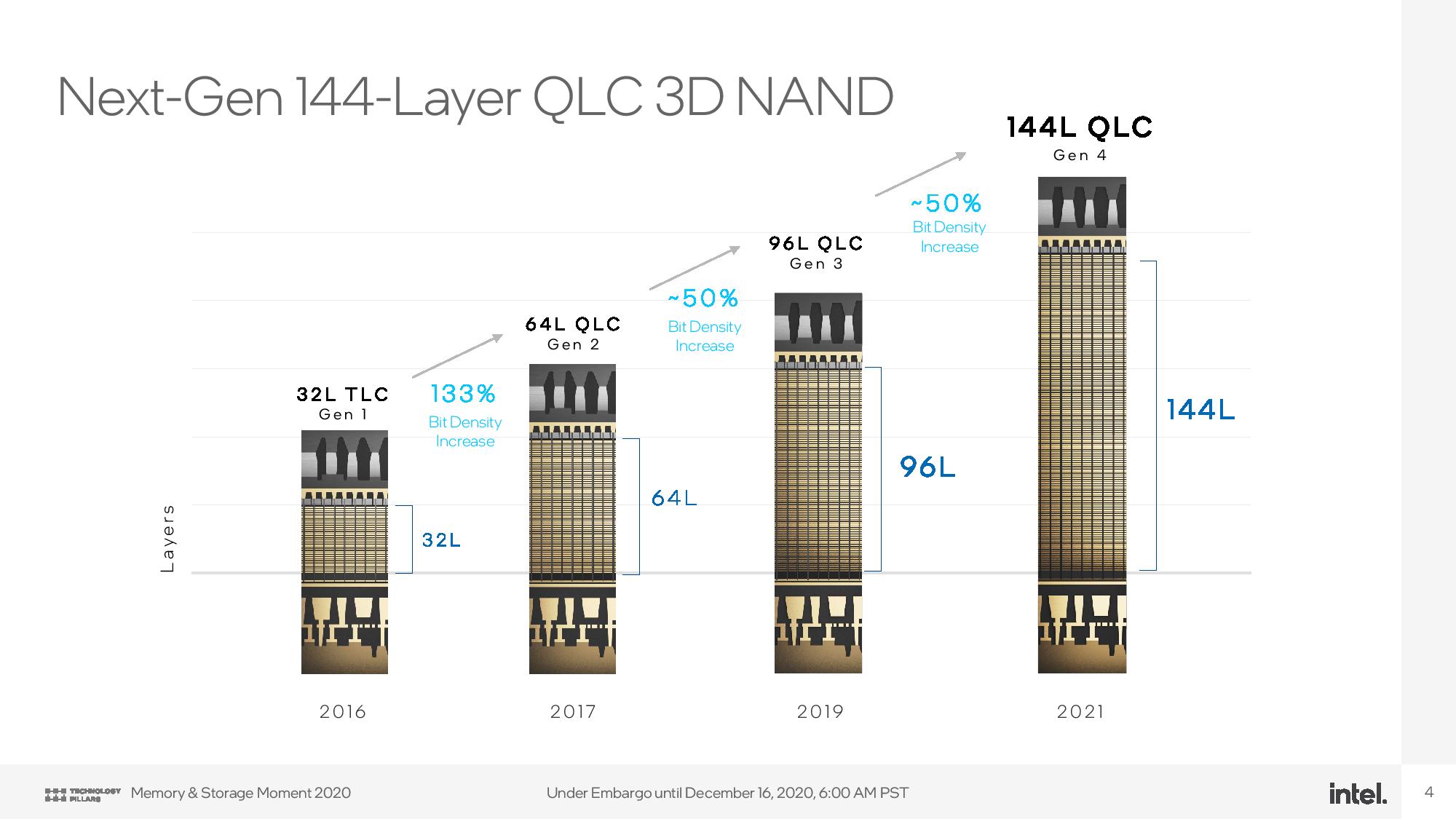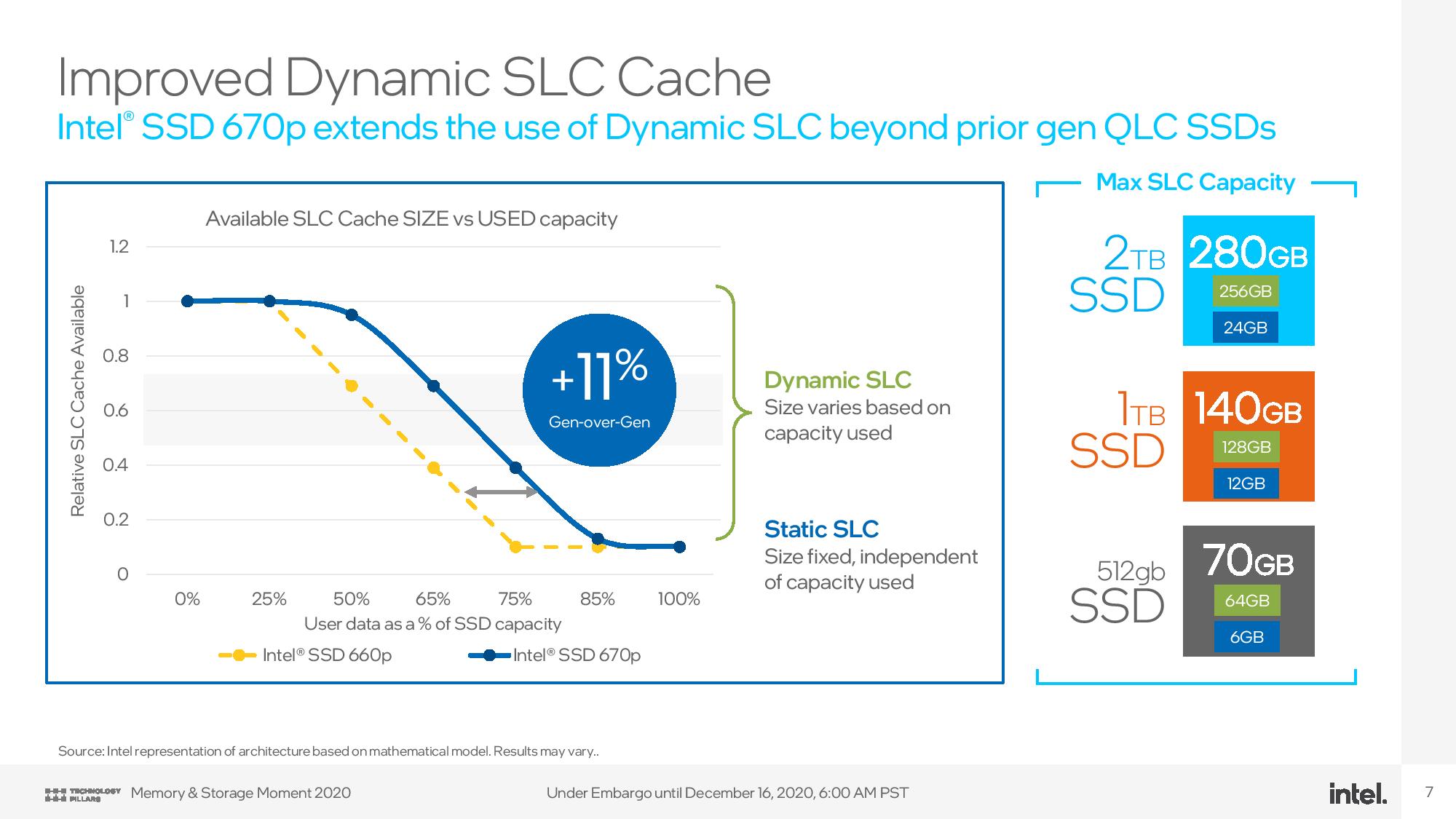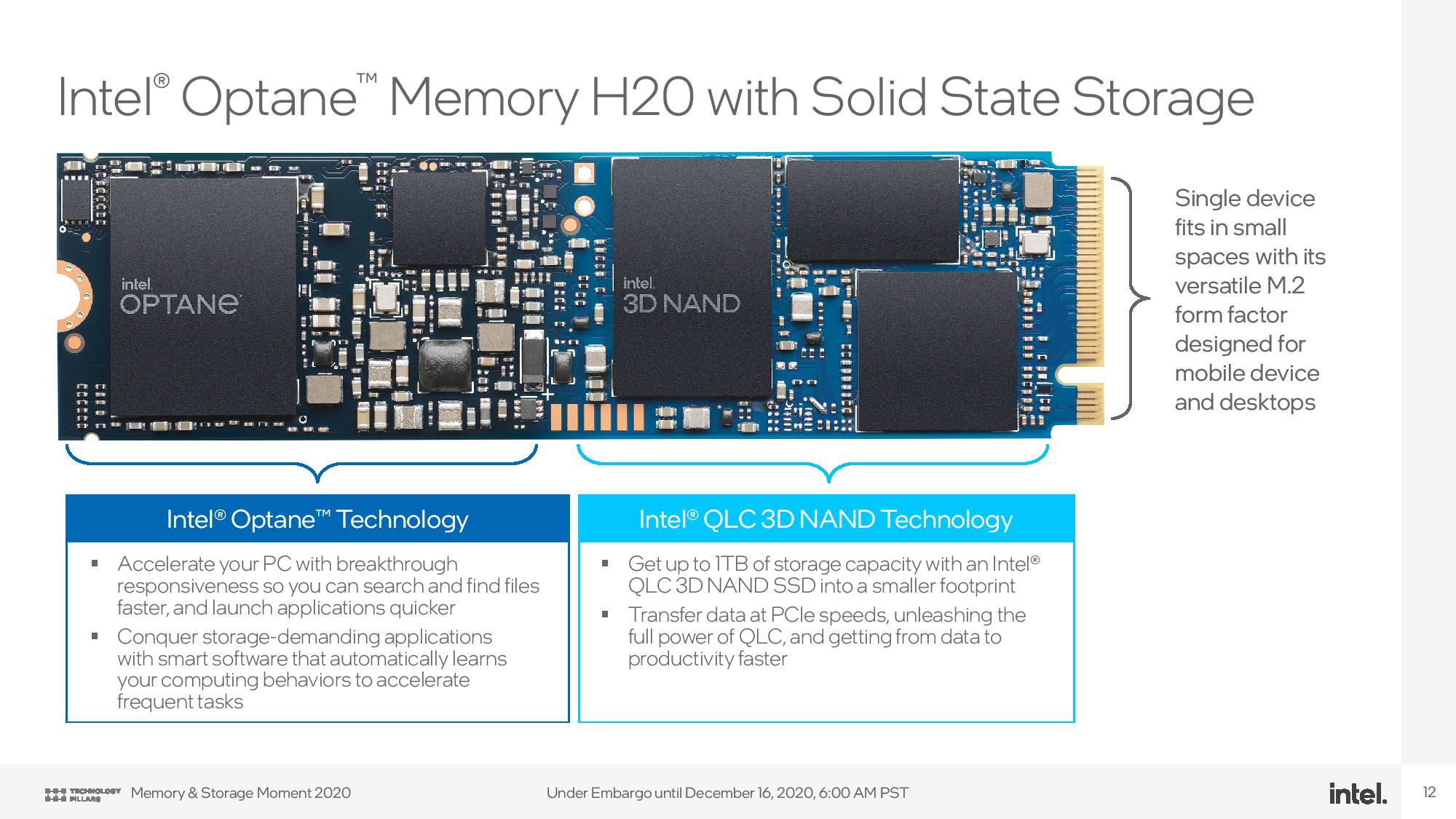Intel Teases 5-bit PLC Flash, Introduces SSD 670p and Optane Memory H20
Packing in more flash
Intel announced several new SSDs during its Memory and Storage 2020 event, including the new 3D NAND SSD 670p and the Optane-powered H20 that also comes paired with QLC flash to offer a blend of speed and capacity in a slim package. The company also said that it is on a clear pathway to developing 5-bit-per-cell PLC (Penta-level) flash, allowing the company to replace HDDs for most use-cases.
Intel is at the beginning of a multi-year journey to selling its NAND business to SK hynix. However, the company still plans to operate its SSDs business during the changeover period, and all existing products and support will transfer to SK hynix at the conclusion of the deal in several years. For now, it's business as usual for Intel's storage division, as evidenced by its forward-looking announcement that it is on track to developing PLC flash. However, while the company is obviously bullish on the prospects of PLC, it didn't provide any details of when the new flash will come to market.
Intel splits its new consumer SSDs into two M.2 buckets, with the SSD 670p designed for mainstream use. In contrast, the Optane Memory H20 is designed primarily for laptops and OEMs but slots in for applications that require higher levels of performance, like gaming, content creation, and productivity applications. Intel didn't announce any new SATA SSDs for the PC market, which isn't entirely surprising as the SATA segment has largely developed into the type of commodity business that typically hasn't been a focus for Intel.




Both the 670p and the H20 use Intel's 144-Layer flash that it fabricates with Micron, and both of Intel's new SSD use density-increasing QLC flash to both reduce cost and boost capacity, though that does come with endurance tradeoffs. Naturally, PLC flash will come with even lower endurance than existing QLC flash, but Intel thinks it's floating gate flash serves as a solid foundation for the new technology.
As we've seen with other SSD vendors, the move to higher-density flash has come coupled with new techniques to provide acceptable levels of endurance, like SLC caching. Intel claims that its floating gate cell design provides superior data retention over the charge trap designs used by its competitors due to superior program/erase voltage thresholds and cell isolation, both of which reduce charge loss over time. The end result is a cheaper, denser flash suitable for use in both consumer and data center applications.
The move to 5-bit-per-cell PLC flash is inevitable, Toshiba announced its intentions to develop the tech back in 2019, and Intel hopes to leverage its floating gate design to enable higher densities while maintaining acceptable performance and endurance characteristics. However, it remains unclear if the new flash will debut while Intel still fabricates its own flash, or if PLC flash will come after the SK hynix takeover.
Intel claims that 5-bit-per-cell PLC flash will help to unseat HDDs on a total cost of ownership (TCO) basis in 2022, but this measurement also factors in the space, power, and cooling costs associated with using a storage device. That means that while PLC SSDs will help SSDs become more competitive with HDDs on an overall cost basis, we likely won't see SSD pricing match HDDs soon.
Get Tom's Hardware's best news and in-depth reviews, straight to your inbox.




Intel hasn't shared detailed performance specifications for its SSD 670p SSDs yet, but the new SSDs will replace the SSD 660p and SSD 665p that have served as go-to value drives for several years.
The SSD 670p still leverages the PCIe 3.0 interface, which will inevitably lead to reduced throughput compared to competing PCIe 4.0 SSDs, but it comes armed with a next-gen Intel SSD controller that the company hasn't fully detailed yet. We do know that the SSD comes in 512GB, 1TB, and 2TB flavors and supports Pyrite 2.0 security, end-to-end data protection, and endurance ratings of 150 terabytes written (TBW) per 512GB of capacity. That puts the range-topping 2TB model at an acceptable endurance of 600 TBW, matching the previous-gen 665p.
Intel refined the 670p's dynamic cache, which helps boost both endurance and performance by using an adaptive amount of SLC-programmed flash to absorb data headed to the underlying QLC flash, by increasing the amount of available cache when the drive is full. Intel has improved the cache capacity by 11% when the drive is more than 35% full. As before, the drive keeps a pre-programmed amount of static cache regardless of drive fill, as outlined in the final slide in the above album.
Intel will launch the SSD 670p in Q1, 2021, and we expect to learn further details, including performance specifications, at launch.







Intel continues to focus on the laptop market with its next-gen H-series 'Pyramid Glacier' SSD. As with the previous-gen SSD H10, Intel's PCIe 3.0 Optane Memory H20 uses QLC flash to increase capacity and reduce cost, while a separate Optane portion of storage steps in to increase both performance and endurance. The SSD leverages Intel's existing RST software to cache frequently-accessed data on the faster Optane storage media, thus boosting performance over what we typically expect from TLC SSDs – but with less-expensive QLC flash.
Intel squeezes both 144-Layer QLC flash and Optane storage, each with its own new controller, onto a single M.2 gumstick. The previous-gen H10 came with a 256GB model but Intel chose to only offer 1TB and 2TB models for the H20 series, with the former coming with 16GB of Optane memory, while the latter has 32GB. Intel chose to stick with the PCIe 3.0 interface because the drive is designed for low latency operation as opposed to delivering higher throughput that would benefit from the PCIe 4.0 interface. PCIe 3.0 also consumes far less power than the PCIe 4.0 interface, which is more attractive to OEM laptop manufacturers.
These SSDs require special accommodations, so they are confined to OEM systems with the 500-series chipset and Intel's 11th-gen U-Series processors. These SSDs will come to market in the second quarter of 2021.

Paul Alcorn is the Editor-in-Chief for Tom's Hardware US. He also writes news and reviews on CPUs, storage, and enterprise hardware.
-
cyrusfox You have one of your facts mistaken,Reply
Both the 670p and the H20 use Intel's 144-Layer flash that it fabricates with MicronIntel does not manufacturer NAND with Micron anymore and hasn't since 96L(perhaps they are still purchasing wafers from those codeveloped generations).
Intel is the only NAND player to use the unique layer count of 144L.
Micron went from 96L to 128(Switched to Replacement gate from floating gate), and now they are on 176L.
On the optane side front, for the H20, I do believe that is sourced from Micron and their old partnership.
5 bit cell is fascinating to think about, 32 Separate electrical charge states. NAND is continuing to find ways to scale.
I don't get the artifical segmentation for the H20 (Why only new platforms that aren't released on the desktop space). If the H10 works with the platform(PCIE bifurcation support) I see no reason why the H20 similiary can't be enabled. They would get so much more market adoptation if they made it easier to add to a platform as well, the H10 right now can be found on ebay the 512/32GB model for $50-70, but it is very hit or miss to get it working on the desktop. From what I can tell all Z490 boards can support it, and from the 300 series boards it was much more a matter of vendor bios support for the bifuraction. -
Shadowclash10 Honestly, my biggest question is more about whether it is a great value like its 660p and 665p predecessors.Reply